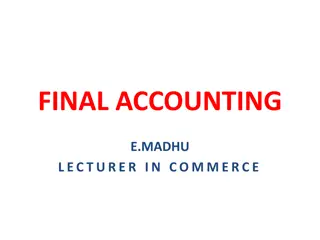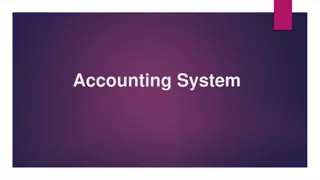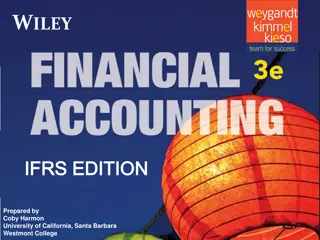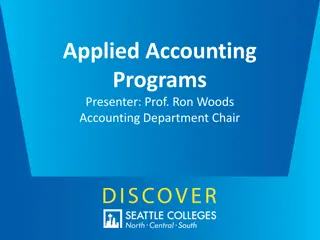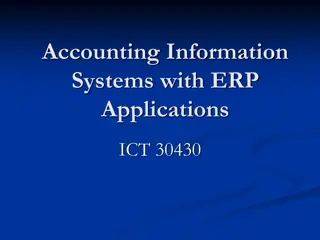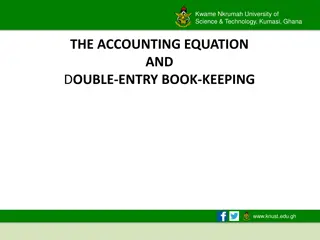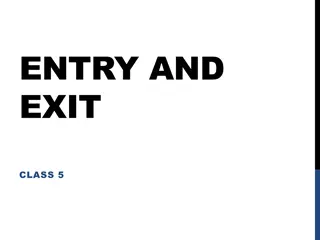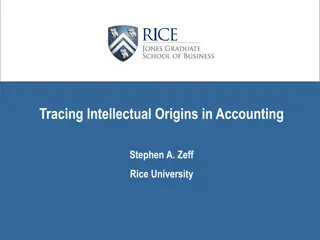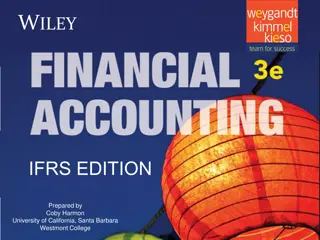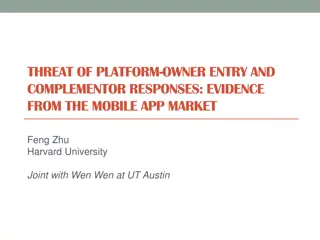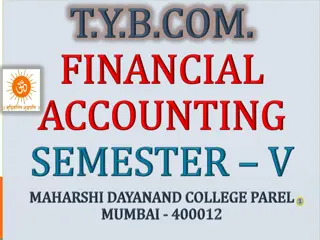Understanding Single Entry System in Financial Accounting
Single Entry System is a simplified method used by small businesses to track their financial transactions. It lacks the rigor of double-entry bookkeeping and focuses on recording cash transactions and personal accounts. This system presents challenges in accurately determining profits and financial positions. The differences between Single Entry System and Double Entry System highlight the limitations of Single Entry in terms of record-keeping, accuracy, and financial analysis.
Download Presentation

Please find below an Image/Link to download the presentation.
The content on the website is provided AS IS for your information and personal use only. It may not be sold, licensed, or shared on other websites without obtaining consent from the author. Download presentation by click this link. If you encounter any issues during the download, it is possible that the publisher has removed the file from their server.
E N D
Presentation Transcript
FINANCIAL ACCOUNITING FINANCIAL ACCOUNITING SINGLE ENTRY SYSTEM SINGLE ENTRY SYSTEM SUBJECT CODE: SUBJECT CODE: 20UCO2C3 20UCO2C3 Prepared by Prepared by K.BEEMA RAO M.Com ., M.Phil. ASSISTANT PRFESSOFER PG & RESEARCH DEPARTMENT OF COMMERCE (SF - MEN) JAMAL MOHAMED COLLEGE (AUTONOMOUS) TIRUCHIRAPPALLI 620 020
INTRODUCTION TO SINGLE ENTRY SYSTEM Very often small sole proprietorship and partnership businesses do not maintain double entry book keeping system. Sometimes they keep record of transactions only. Sometimes they do not maintain records of all transactions. But at the end of the accounting period they want to know the performance and financial position of their businesses. This creates some special problems to the accountants. This chapter discusses how to complete the accounts from available incomplete records. The term Single Entry System is popularly used to describe the problems of accounts from incomplete records. In practice, the quack accountants follow some hybrid methods. For some transactions they complete double entries. For some others they just maintain one entry. Still for some others, they even do not pass any entry. Briefly, this may be stated as incomplete records. The task of the accountant is to establish linkage among the available information and to finalise the accounts. the cash transactions and credit
FEATURES OF SINGLE ENTRY SYSTEM FEATURES OF SINGLE ENTRY SYSTEM 1. It is an inaccurate, unscientific and unsystematic method of recording business transactions. 2. There is generally no record of real and personal accounts and, in most of the cases; a record is kept for cash transactions and personal accounts. 3. Cash book mixes up business and personal transactions of the owners. 4. There is no uniformity in maintaining the records and the system may differ from firm requirements and convenience of each firm. 5. Profit under this system is only an estimate based on available information and therefore true and correct profits cannot be determined. The same is the case with the financial position in the absence of a proper balance sheet. to firm depending on the
DIFFERENCE BETWEEN SINGLE ENTRY AND DOUBLE ENTRY DIFFERENCE BETWEEN SINGLE ENTRY AND DOUBLE ENTRY SYSTEM SYSTEM Single entry system Double entry system i) Both aspects of an entry are recorded Both aspects of an entry may not be recorded (ii) Personal, real, and nominal accounts are kept Only personal accounts are maintained (iii) Cash book, general ledger, debtor's ledger, and creditor's ledger are maintained Only the debtor's ledger and the creditor's ledger are kept (iv) Mathematical accuracy can be checked as the trial balance is available Trial balance cannot be prepared, meaning that mathematical accuracy cannot be checked Due to the absence of the trial balance, the trading account and profit and loss account cannot be prepared (v) Trading account and profit and loss account can be prepared Important ratios like the gross profit ratio and net profit ratio cannot be computed (vi) Various accounting ratios can be computed (vii) A scientific system that follows a specific set of rules The system is unscientific and does not follow any set of rules
STATEMENT OF AFFAIRS A statement of affairs, like a balance sheet, is a statement which shows the assets and liabilities of a concern on a particular date and reveals its financial state of affairs. Many of the assets and liabilities shown on this statement are based on the estimates made by the proprietor. They are not based on book values as in case of balance sheet. Statement of affairs is prepared to ascertain the financial position and capital investments in the organization where books of accounts are not properly maintained or may be destroyed. The values of various assets and liabilities of the concern are ascertained as under: 1. Cash in hand: It is ascertained from cash book or through physical verification of cash in hand Cash with bank: It is ascertained by balancing cash book. In case the cash book has no bank column it is confirmed on the basis of pass book or bank records. 2. Debtors & creditors: They are calculated from the personal ledgers maintained by the concern. 3. Stock in trade: It is valued on the basis of actual stock taking and valuation. 4. Fixed Assets: The values of fixed assets owned by concern like furniture, machinery & equipment's, buildings, vehicles etc., are judged from available records or by estimates. 5. Other values: The other values such as outstanding expenses and incomes, prepaid expenses, loans and incomes received in advance etc., are found from available records and memory of proprietor or partners. vii) Capital : Finally, the excess of assets over liabilities is taken as capital.
The ProForma of Statement of Affairs is as under : Statement of affairs method Labilities Rs Assets Rs. Creditors XXX Cash in Hand XXX Bills Payable XXX Cash at Bank XXX Loans & Overdrafts XXX Cash at Bank XXX Loans & Overdrafts XXX Outstanding Income XXX Capital (Balancing figure) XXX Debtors XXX Stock XXX Investments XXX Furniture & Fittings XXX Plant & Machinery XXX Buildings & Land XXX
PROBLEM 1 Mr. Rafi maintains his books on single entry system you are the information Particulars Rs Capital as on 1.1.1992 Capital as on 1.1.1993 Drawings during the year 1992 Capital introduced August 1992 32,000 36,000 10,000 6,000 Answer: Calculate the statement of Profit Particulars Rs Closing capital 1.1.93 36,000 Add: Drawings during the year 10,000 46,000 Less: Capital introduced on Aug 1992 40,000 Opening Capital 1.1.1992 32,000 Profit 8,000
PROBLEM - 2 Calculate the capital beginning of the year Particulars Rs Capital at the end of the year 35,000 Drawings during the year 5000 Capital introduced during the year 2500 Answer: Profit during the year 10,000 Rs Capital at the end of the year 35,000 Add: Drawings during the year 5,000 40,000 Less : Capital introduced during the year 2500 37,500 27,500 Less: Opening Capital Profit during the year 10,000
PROBLEM - 3 A trader keeps his books using the single entry system. He started his business on 1 January 2019 with a total capital amount of Rs.100,000. On 1 July 2019, he borrowed Rs.40,000 at 10% p.a. Additionally, on 31 December 2019, his assets and liabilities (besides the above) were: 1. Cash: Rs.6,000 2. Stock in trade: Rs.94,000 3. Debtors: Rs.71,000 4. Furniture: Rs.50,000 (charge 10% depreciation on furniture) 5. Creditors: Rs.42,000 6. The trader drewRs.2,500 for personal use. During the year, he further invested Rs.25,000 through the sale of his private property. Required: Ascertain the trader s profit or loss for the year.
CONVERSION METHOD CONVERSION METHOD 1. The process of collecting, 2. computing and recording available data in the incomplete books of a business is called 3. conversion method'. Once the books are 'converted', all future can be recorded as per 'double entry system'. 4. Need for Conversion: 5. The net worth method does not provide a clear picture operating results of a business. It does not show sales, purchases, gross fit, operating expenses etc. 6. So it is not possible to make a meaningful analysis of the financial statements and initiate effective steps to improve the financial position of the business. Conversion to double entry system enables a business to avoid the harassment of taxation authorities and ensures better management of the business. 7. The following are the steps to be followed for Conversion of incomplete records as per the requirements of Double entry system. missing information along with the
Step 1 : Statement of affairs at the beginning of the year from which conversion is to be effected should be prepared. The balance in the statement represents opening capital. In problems, it may not be possible to complete the statement due to missing opening balances like Debtors, Creditors, Stock. The statement should be prepared to the extent possible and can be completed at a later stage. Step 2: Cash book with Cash and Bank columns or a single column should be prepared. Careful scrutiny of bank pass book and enquiry relating to cash 'takings' used by the owner for personal expenses and payments are essential. In problems, opening or closing cash or bank balances may be missing. The balance in the cash book represents the missing figure. Cash book must be prepared even when the opening and closing balances of cash and bank are given. Any shortage on the debit side can be cash sales or additional capital Introduced or sundry income. Shortage on the credit side can be cash purchases or drawings or sundry expenses, Step 3: Bills receivables account, bills payables account, total debtors account and total creditors Preparation of these accounts can help in finding any missing items like opening or closing debtors, opening or closing creditors, credit purchases and sales etc. Total sales and total purchases can be found by adding cash and credit sales and also cash and credit purchases account must be prepared.
If opening or closing stock is missing, preparation of memorandum trading account after ascertaining gross profit ratio can reveal the opening or closing stock whichever is not given. Step 4: Opening statement of affairs can now be completed, by filling up figure and opening capital can be ascertained. Step 5: Appropriate journal entry should be passed in res liabilities included in the opening statement of affairs. sill Step 6: Real and nominal accounts must be written from recorded in the cash book, total debtors account, total creditors account etc. The double effect of every entry must be posted to the ledger, accounts wherever necessary Step 7: All the accounts in the ledger must be balanced balance should be extracted. Step 8: From the trial balance and any other additional details trading account, profit and loss account and balance sheet must be prepared Note: step 5. 6 and 7 are not needed to solve examination problems The following table shows the figures which are usually missing and the appropriate account from which they can be found




